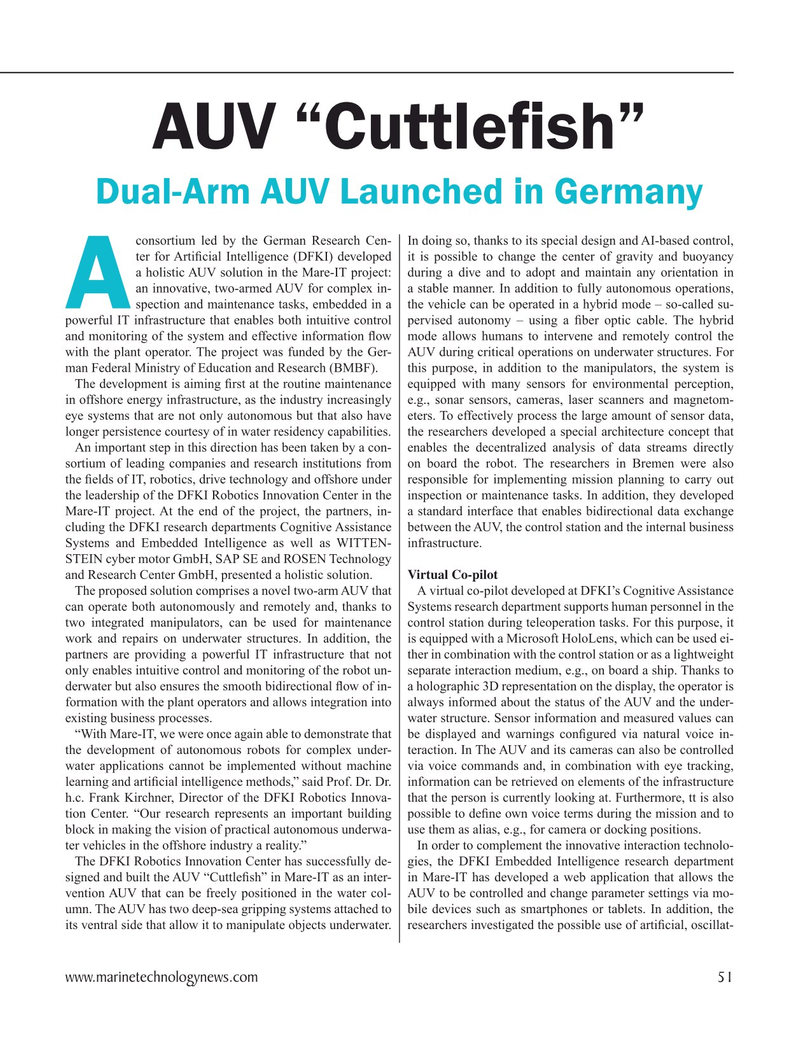
Page 51: of Marine Technology Magazine (May 2022)
Read this page in Pdf, Flash or Html5 edition of May 2022 Marine Technology Magazine
AUV “Cuttle? sh”
Dual-Arm AUV Launched in Germany consortium led by the German Research Cen- In doing so, thanks to its special design and AI-based control, ter for Arti? cial Intelligence (DFKI) developed it is possible to change the center of gravity and buoyancy a holistic AUV solution in the Mare-IT project: during a dive and to adopt and maintain any orientation in an innovative, two-armed AUV for complex in- a stable manner. In addition to fully autonomous operations,
A spection and maintenance tasks, embedded in a the vehicle can be operated in a hybrid mode – so-called su- powerful IT infrastructure that enables both intuitive control pervised autonomy – using a ? ber optic cable. The hybrid and monitoring of the system and effective information ? ow mode allows humans to intervene and remotely control the with the plant operator. The project was funded by the Ger- AUV during critical operations on underwater structures. For man Federal Ministry of Education and Research (BMBF). this purpose, in addition to the manipulators, the system is
The development is aiming ? rst at the routine maintenance equipped with many sensors for environmental perception, in offshore energy infrastructure, as the industry increasingly e.g., sonar sensors, cameras, laser scanners and magnetom- eye systems that are not only autonomous but that also have eters. To effectively process the large amount of sensor data, longer persistence courtesy of in water residency capabilities. the researchers developed a special architecture concept that
An important step in this direction has been taken by a con- enables the decentralized analysis of data streams directly sortium of leading companies and research institutions from on board the robot. The researchers in Bremen were also the ? elds of IT, robotics, drive technology and offshore under responsible for implementing mission planning to carry out the leadership of the DFKI Robotics Innovation Center in the inspection or maintenance tasks. In addition, they developed
Mare-IT project. At the end of the project, the partners, in- a standard interface that enables bidirectional data exchange cluding the DFKI research departments Cognitive Assistance between the AUV, the control station and the internal business
Systems and Embedded Intelligence as well as WITTEN- infrastructure.
STEIN cyber motor GmbH, SAP SE and ROSEN Technology and Research Center GmbH, presented a holistic solution. Virtual Co-pilot
The proposed solution comprises a novel two-arm AUV that A virtual co-pilot developed at DFKI’s Cognitive Assistance can operate both autonomously and remotely and, thanks to Systems research department supports human personnel in the two integrated manipulators, can be used for maintenance control station during teleoperation tasks. For this purpose, it work and repairs on underwater structures. In addition, the is equipped with a Microsoft HoloLens, which can be used ei- partners are providing a powerful IT infrastructure that not ther in combination with the control station or as a lightweight only enables intuitive control and monitoring of the robot un- separate interaction medium, e.g., on board a ship. Thanks to derwater but also ensures the smooth bidirectional ? ow of in- a holographic 3D representation on the display, the operator is formation with the plant operators and allows integration into always informed about the status of the AUV and the under- existing business processes. water structure. Sensor information and measured values can “With Mare-IT, we were once again able to demonstrate that be displayed and warnings con? gured via natural voice in- the development of autonomous robots for complex under- teraction. In The AUV and its cameras can also be controlled water applications cannot be implemented without machine via voice commands and, in combination with eye tracking, learning and arti? cial intelligence methods,” said Prof. Dr. Dr. information can be retrieved on elements of the infrastructure h.c. Frank Kirchner, Director of the DFKI Robotics Innova- that the person is currently looking at. Furthermore, tt is also tion Center. “Our research represents an important building possible to de? ne own voice terms during the mission and to block in making the vision of practical autonomous underwa- use them as alias, e.g., for camera or docking positions. ter vehicles in the offshore industry a reality.” In order to complement the innovative interaction technolo-
The DFKI Robotics Innovation Center has successfully de- gies, the DFKI Embedded Intelligence research department signed and built the AUV “Cuttle? sh” in Mare-IT as an inter- in Mare-IT has developed a web application that allows the vention AUV that can be freely positioned in the water col- AUV to be controlled and change parameter settings via mo- umn. The AUV has two deep-sea gripping systems attached to bile devices such as smartphones or tablets. In addition, the its ventral side that allow it to manipulate objects underwater. researchers investigated the possible use of arti? cial, oscillat- www.marinetechnologynews.com 51
MTR #4 (50-63).indd 51 4/28/2022 9:12:27 AM

 50
50

 52
52
